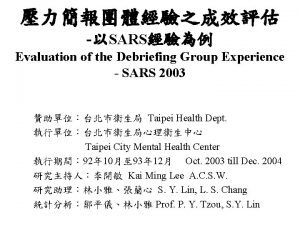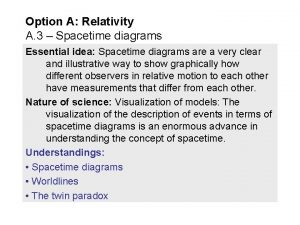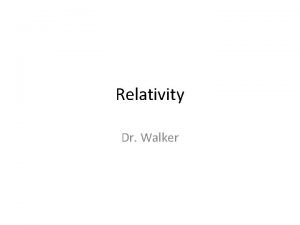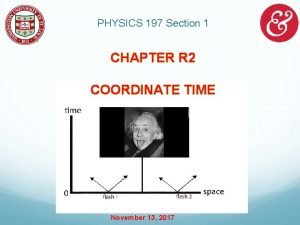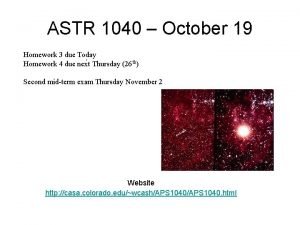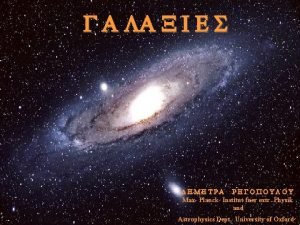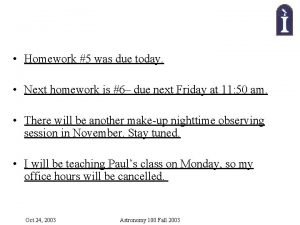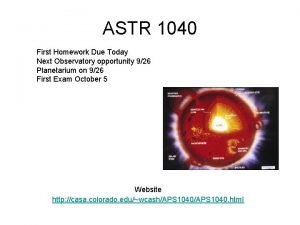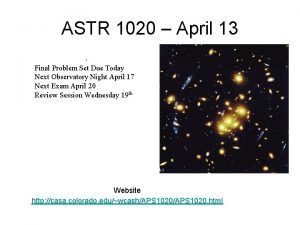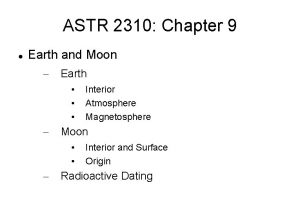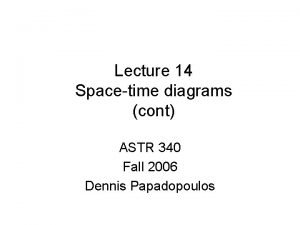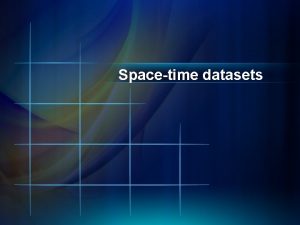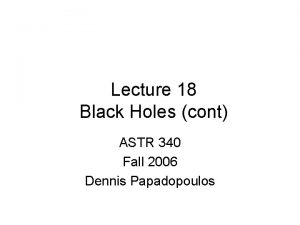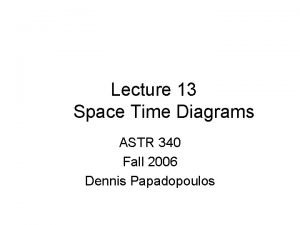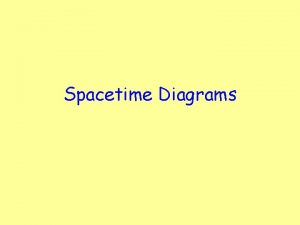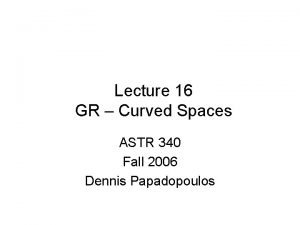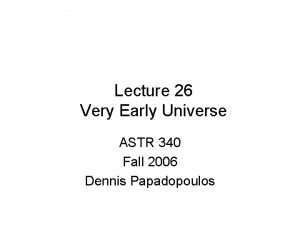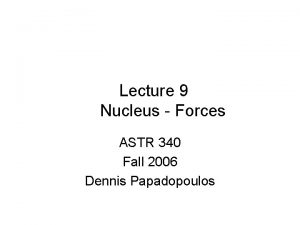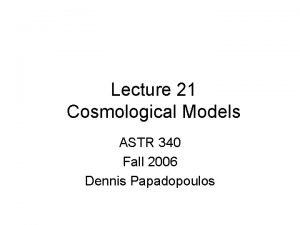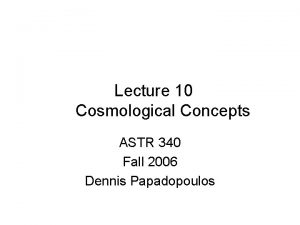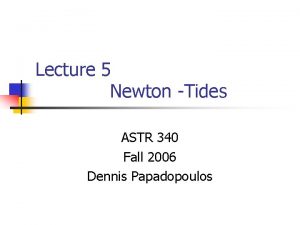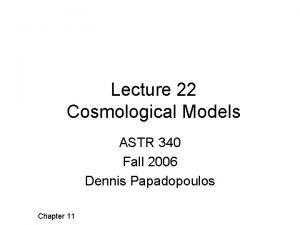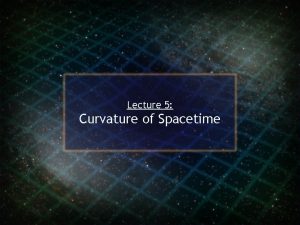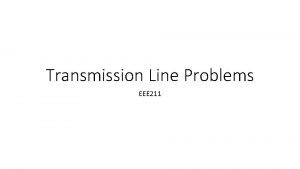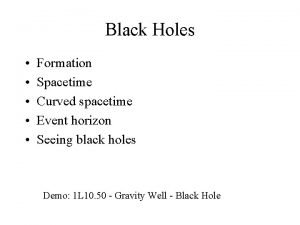Lecture 14 Spacetime diagrams cont ASTR 340 Fall

















- Slides: 17

Lecture 14 Space-time diagrams (cont) ASTR 340 Fall 2006 Dennis Papadopoulos

E=mc 2 mo rest mass Energy due to mass -> rest energy moc 2 9 x 1016 J per kg of mass Energy due to motion Kinetic Energy (1/2) mv 2 Relativistic mass m= m 0

Space-time interval ct ct 2 Space-time interval defined as (x 1, ct 2) c t ct 1 (x 2, ct 1) x x 1 x 2 x What is the space time interval on a lightcone? Invariant independent of frame that is measured Physical interpretation Measure time with a clock at rest to the observer x=0 -> s=c t 0

• Spacetime diagrams in different frames Changing from one reference frame to another… – Affects time coordinate (time-dilation) – Affects space coordinate (length contraction) – Leads to a distortion of the space-time diagram as shown in figure. • Events that are simultaneous in one frame are not simultaneous in another frame ct f q x v/c=tanf=cotq

Space-time interval ct’ ct B A Space-time interval invariant All inertial observers will agree on the value of s, e. g. 2 lightyears, although they will disagree on the value of the time interval and distance interval x’ x

Reciprocity

Different kinds of space-time intervals Time-like: s 2>0 Light-like: s 2=0 “light like” “Light Cone” Space-like: s 2<0 “time like” “Space like”

Causality B Can I change the time order of events by going to another reference frame? A

• Events A and B… Causality – Cannot change order of A and B by changing frames of reference. – A can also communicate information to B by sending a signal at, or less than, the speed of light. – This means that A and B are causallyconnected. • Events A and C… – Can change the order of A and C by changing frame of reference. – If there were any communication between A and C, it would have to happen at a speed faster than the speed of light. • If idea of cause and effect is to have any meaning, we must conclude that no communication can occur at a speed faster than the speed of light.

The twin paradox • Suppose Andy (A) and Betty (B) are twins. • Andy stays on Earth, while Betty leaves Earth, travels (at a large fraction of the speed of light) to visit her aunt on a planet orbiting Alpha Centauri, and returns • When Betty gets home, she finds Andy is greatly aged compared herself. • Andy attributes this to the time dilation he observes for Betty’s clock during her journey • Is this correct? • What about reciprocity? Doesn’t Betty observe Andy’s clock as dilated, from her point of view? Wouldn’t that mean she would find him much older, when she returns? • Who’s really older? ? What’s going on? ? ?

Andy’s point of view • • • Andy’s world line, in his own frame, is a straight line Betty’s journey has world line with two segments, one for outbound (towards larger x) and one for return (towards smaller x) Both of Betty’s segments are at angles 45 to vertical, because she travels at v c ct If Andy is older by t years when Betty returns, he expects that due to time dilation she will have aged by t/ years Since 1/ = (1 -v 2/c 2)1/2 1, Betty will be younger than Andy, and the faster Betty travels, the more difference there will be B (return) A B (outbound) x

Betty’s point of view • Consider frame moving with Betty’s outbound velocity • Andy on Earth will have straight world line moving towards smaller x • Betty’s return journey world line is not the same as her outbound world line, instead ct pointing toward smaller x • Both Andy’s world line and Betty’s return world line are at angles 45 to vertical (inside of the light cone) • Betty’s return world line is closer to light cone than Andy’s world line B (return) A (outbound) BB(outbound) x § For frame moving with Betty’s return velocity, situation is similar

Twin Paradox =1. 5 v=. 74 c

Solution of the paradox • From any perspective, Andy’s world line has a single segment • From any perspective, Betty’s world line has two different segments • There is no single inertial frame for Betty’s trip, so ct reciprocity of time dilation with Andy cannot apply for whole journey • Betty’s proper time is truly shorter -- she is younger than Andy when she returns B (return) A B (outbound) x

Different kinds of world lines B (return) ct A B (outbound) x x • Regardless of frame, Betty’s world line does not connect start and end points with a straight line, while Andy’s does • This is because Betty’s journey involves accelerations, while Andy’s does not

More on invariant intervals • • • Considering all possible world lines joining two points in a space-time diagram, the one with the longest proper time (=invariant interval) is always the straight world line that connects the two points The light-like world lines (involving reflection) have the shortest proper time -- zero! Massive bodies can minimize their proper time between events by following a world line near a light-like world line ct x

SR Summary
 Debriefing report
Debriefing report Cont or cont'd
Cont or cont'd Spacetime diagram examples
Spacetime diagram examples Spacetime walker
Spacetime walker De sitter spacetime
De sitter spacetime Spacetime coordinates review
Spacetime coordinates review Astr
Astr Bracione
Bracione That was due today
That was due today Astr
Astr Astr
Astr M tallman 2014 www gottoteach com answers
M tallman 2014 www gottoteach com answers Quasar spectrum
Quasar spectrum Astr
Astr Inertial observers
Inertial observers Astr greek or latin
Astr greek or latin Use case model
Use case model An activity diagram is a static model.
An activity diagram is a static model.
